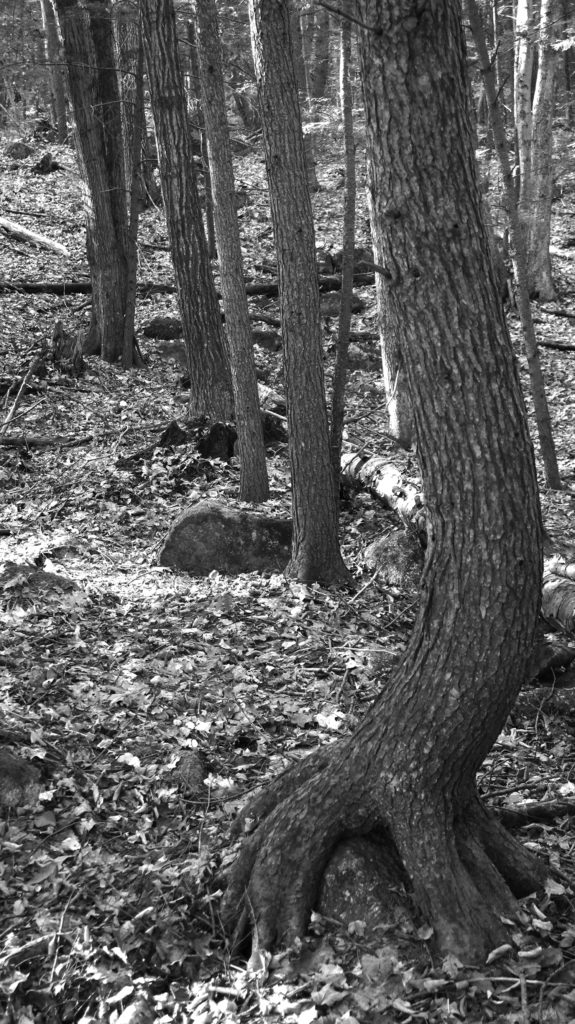Village Gardener: Woodlands and trees – magical realms
 by Georgeanne Vyverberg –
by Georgeanne Vyverberg –
Back in early December temperatures were in the 40’s and 50’s. It was wonderful to have all those lovely days to be outside, and for me I couldn’t believe I was getting even the smallest garden tasks checked off my list. However, it also worried me to see those grape hyacinths I planted back in late September putting up those spiky like leaves, some three inches tall! Most precocious bulbs will not be harmed unless the flower buds appear. However not wanting my garlic to spring up I put an additional layer of mulch in the form of mowed over leaves. If garlic comes up it is in danger of getting frozen and although it will restart in spring, it can result in smaller bulbs.
Another thing I could not help but notice while raking endless leaves, were the abundance of those little things we used to call helicopters when we were kids, because of the way they gently spun from the trees. They are also known as whirligigs, polynose and in England a spinning jenny, but the botanical name for this fruit is a samara. I’d never seen so many as I saw this year. It has also been reported that there was an unusually large production of acorns. This phenomenon has been described as a Mast year. There have been several theories about why we should have such over the top production in any particular year, since there doesn’t seem to be any discernible pattern. The most common explanation is that trees save their energy when conditions are less than optimal and surely that was the case in the Summer of 2016, when conditions were so hot and dry, I remember not needing to mow the lawn for six weeks. Nice for me, but not the trees.
While on the subject of trees I heartily recommend a book entitled The Hidden Life of Trees by Peter Wohlleben. The author worked for 20 years in a forest in Germany and has written several books about trees. The book’s subtitle is What They Feel, How They Communicate. How irresistible! Every chapter pulls you into the next. Trees communicate by chemicals and electrical energy. They defend themselves and others and help one another grow and flourish. For example, giraffes in Africa like acacia trees, but as soon as they begin to consume them the trees release a chemical that makes them unpalatable to the giraffes and they soon move onto another patch of the trees further away. The nearby trees have “smelled” the chemical and also have begun to produce it. We find out in this book that trees are social beings and that the “wood wide web” of soil fungi and microorganisms also contribute to their society. It’s an amazing book and after reading it you may not be able to see trees in the same light again.
This book brings to mind a practice known as “forest bathing”, which has become the newest fad akin to yoga and meditation and mindfulness practice. It is simply the action of entering the woodlands and experiencing what is found there. I had to shake my head on first encountering this idea. Really? I bet you could ask any child fortunate enough to have free and easy access to a woodland if they feel better and even safer there and the answer is a resounding yes! Think back to when you were a child and how you felt playing there. It was magical and you could imagine all sorts of worlds. Somehow, we forget or as my friend told me recently, she was ridiculed for telling her parents that the trees “spoke to her”. For me it was the Lilliputian world of mosses and ferns that drew my attention. At any rate check out the book mentioned above. Most libraries have a copy and as a former librarian I like to encourage their use. Your taxes pay for them after all.
I always welcome these cold winter days after the rush and bustle of the holidays. It’s a time of quiet peacefulness and a sense of renewal. A kind of turning inward. For a gardener there is time to contemplate and plan next year’s garden, whether it’s a small perennial bed or a vegetable garden or the addition of new shrubs and trees. Its also the best time to curl up with a book. Here is another favorite of mine. The Wild Braid: A Poet Reflects on a Century in the Garden by Stanley Kunitz .
Mr.Kunitz has been the U.S. Poet Laureate and has won just about every Literary Prize that can be won. This small volume, with many photographs of the author in his various gardens, reveals how he feels about the similarities of his work in the garden and on the written page. For him they are inseparable. “All I want to do is write poems and be in the garden” he wrote when miraculously recovering from a near fatal illness. Here is another quote from Stanley Kunitz. “I associate the garden with the whole experience of being alive.” Isn’t that what we gardeners have always known? That gardens and our work there is our constant connection to this life.